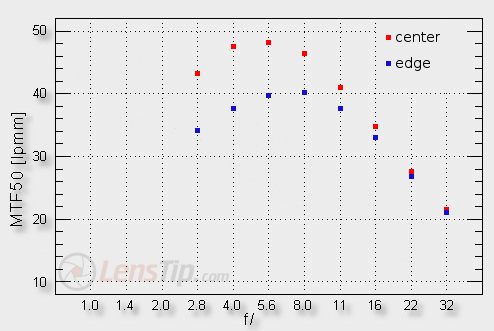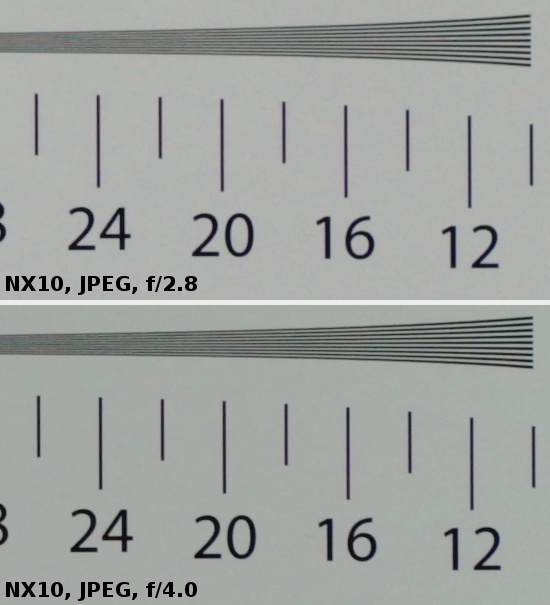Samsung NX 60 mm f/2.8 Macro ED OIS SSA
4. Image resolution
Usually macro lenses are among the sharpest system devices. Small wonder we expected the Samsung 2.8/60 would perform better than any of the “pancakes”, which are always a result of a kind of compromise between optical properties and small dimensions. You can see on a graph below how the tested instrument performed – we present the results for the frame centre and its edge.

Please Support UsIf you enjoy our reviews and articles, and you want us to continue our work please, support our website by donating through PayPal. The funds are going to be used for paying our editorial team, renting servers, and equipping our testing studio; only that way we will be able to continue providing you interesting content for free. |
- - - - - - - - - - - - - - - - - - - - - - - - - - - - - - - - - - - - - - - - - - - - - - - -
When it comes to the frame centre we can praise the Samsung for its performance at the maximum relative aperture, where it gets to a high level of almost 44 lpmm. Photos you shoot there are sharp and really beyond reproach. The maximum results are quite a surprise though – the lens reaches 48 lpmm. Officially it is a worse result than that of the Samsung NX 30 f/2.0. That “pancake” is a great instrument but we expected that a fully-fledged macro lens with bigger dimensions will be optically better. Well, it’s hard to say it is truly worse because the results of 48 and 50 lpmm are close by, especially considering the fact that measurement errors amount to 0,5-1.0 lpmm here. Still a draw in a duel with just a “pancake” (even if it is a good instrument) leaves us feeling unsatisfied. Although the images provided by the Samsung 2.8/60 are really of good quality you can expect some truly record-breaking values here and there are none of those…
How the tested lens performs on the edge of the frame? The Samsung 2.8/60 should be praised again because even at the maximum aperture it provides useful images. The same cannot be said about the Samsung “pancakes” which feel the keenest adverse effects of their small dimensions exactly on the edge. Once again, though, the stopping down of the aperture isn’t as effective as you would like it to be in a brilliant macro lens. The maximum values reach 40 lpmm - once again it is a tad worse than the performance of the Samsung 2/30…
Overall our impressions, concerning the resolution of the tested lens are mixed. On the one hand the image quality is hard to blame – you get useful images across the frame, even at the maximum relative aperture. As you stop down to f/4.0 and f/5.6 the resolution becomes good. Still nowhere you can see those truly outstanding results that many macro lenses, tested by us before, accustomed us to (if you want some proof it is enough to glance at the tests of such instruments as the Canon EF-S 60 mm f/2.8, the Nikkor AF-S Micro 60 mm f/2.8G ED or the Tamron SP AF 60 mm f/2.0 Di II LD (IF) Macro).
At the end we present crops taken from our test chart photos, saved as JPEG files along RAW files used for the analysis presented above.
 |






